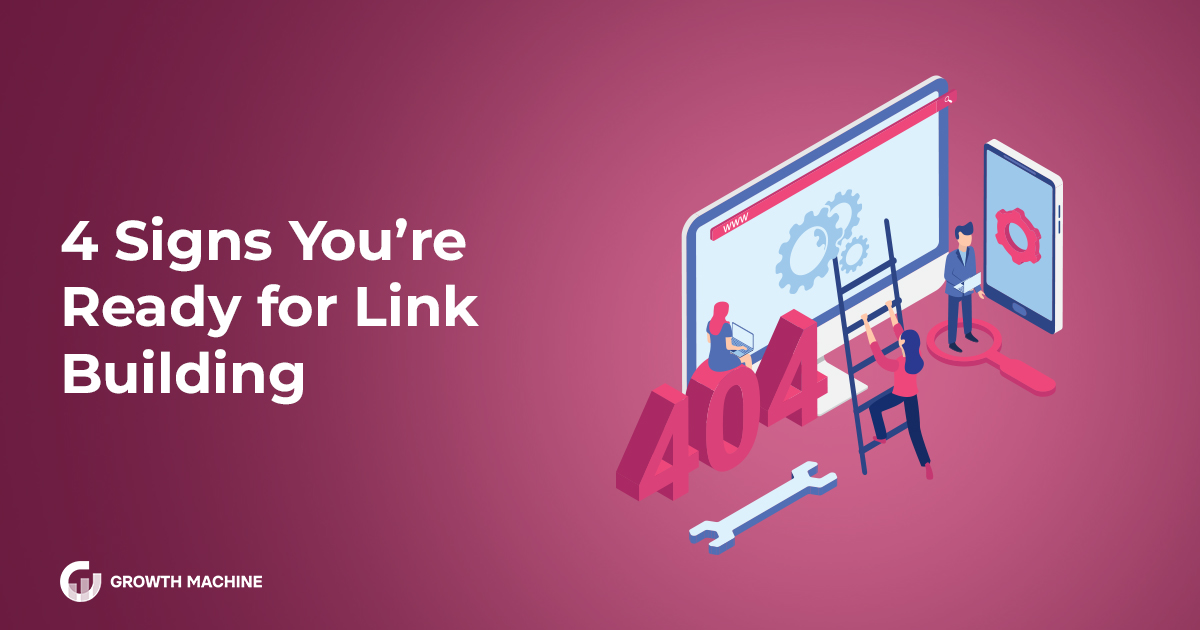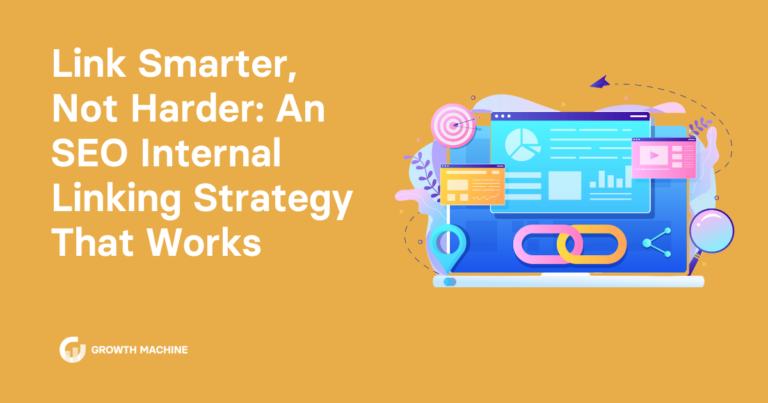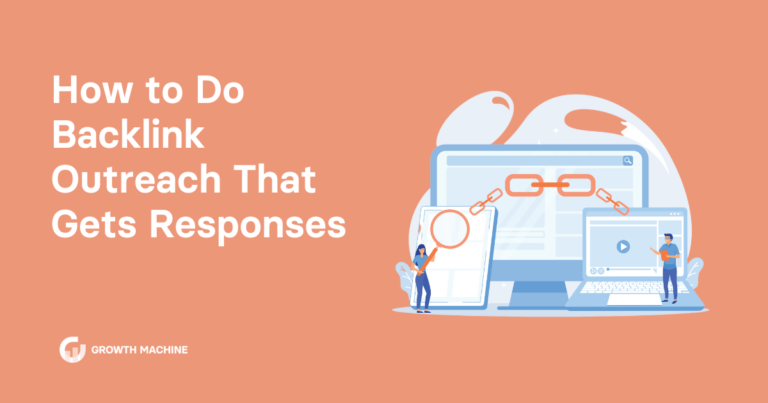4 Signs You’re Ready for SEO Link Building
Great content deserves backlinks. But unless you’re already ranking for a number of keywords or own a high-authority site, it’s difficult to simply earn links without making a concerted effort.
That’s where link building comes in. It’s your opportunity to find spots on other websites for your fantastic content. These backlinks provide you with borrowed authority and in turn, increase your rankings. Then it’ll be easy to earn even more high-quality links — it’s a circular process.
Here you’ll learn the link building fundamentals, how to prepare for a link building campaign, and how to implement the best link building strategies.
If you want to learn this in a visual format, check out our YouTube video below:
What Is SEO Link Building?
Link building, a key component of search engine optimization, is the process of getting other people’s websites to link to yours. Coupled with great content, it helps your web pages rank higher in the search engine results pages (SERPs). Manual link building involves finding opportunities using techniques such as competitor research, broken link building, blogger outreach, and digital PR.
Why Is Link Building Important?
Good content doesn’t necessarily rank on its own even when you’ve optimized every inch of it. Search engine algorithms use multiple factors to assess content and backlinks are one of Google’s top three ranking factors.
Google says it still uses PageRank, an algorithm based on the idea that a link from a high-authority site is a trust signal passing authority to your site. The higher the domain authority, the more authority it sends to you. And the more of these signals you receive, the more authoritative your site looks in the eyes of Google.
In our experience, the links you earn on external websites aren’t the absolute biggest drivers of traffic. But they can make a big difference when paired with regularly producing optimized content, especially when your site is new.
How Link Building Works
To understand how link building works, you first need to grasp these terms and concepts:
- Internal links vs. external links: Internal links point from one page of your website to another. They’re an integral part of your SEO strategy because they indicate a good navigational site structure and help authority flow around your website. External links come from outside websites and point to pages on your site.
- Dofollow links vs. nofollow links: Links contain a piece of code telling Google whether to use the link as a ranking signal (dofollow) or not (nofollow). Your backlink profile (collection of links) should contain a healthy distribution of both types of links, otherwise, it seems unnatural to the search engines.
- Natural vs. unnatural links: Natural links appear earned and unnatural links appear placed through paid or disreputable means purely for the purpose of increasing rankings. To ensure links appear natural, only build links on relevant pages and with natural anchor text (the word or phrase that contains the link).
- High-quality links vs. low-quality links: High-quality links come from high-authority, relevant sources. Low-quality links are the opposite.
- Black hat vs. white hat link building: Black hat link building techniques use shady means to build lots of links in a short period of time, breaking Google’s rules. White hat link building uses techniques to help you earn links organically and won’t be penalized by the search engines.
To succeed at link building, you must build up a good backlink profile using white hat link building techniques. Great content is the foundation that helps you earn those links. Link building campaigns and techniques then help you find link placements from websites looking for high-value resources.
But remember, it’s not enough for people to simply link to you. Backlinks need to be natural and editorially relevant — as in, the content that links out to yours needs to relate to your industry.
Let’s say your website has an article about if dogs can eat kale and the American Kennel Club links to it in their article about making your own dog food. That would be an awesome backlink to have, because the topics are relevant to each other and because as a pet site, the American Kennel Club has a high domain authority.
Those are the high-quality links you want. Not links from random directories that have a ton of outgoing links. Not from paid placements, either. If you buy links, they’ll probably be from a shady website or service, and Google might notice and blacklist you from its search results. Other spammy links or toxic links include links in blog comments, link schemes, and unnatural links in forums like Reddit. These are the low-quality links to be avoided at all costs and manually removed if they appear in your backlink profile.
4 Signs You’re Ready to Start Link Building
The best way to get backlinks is to create the best, most valuable content on any given subject — to create content so good that people will want to link to you.
But as you think about your website’s growth, you’ll need to first focus on the quality of your content before diving into link building tactics. Here’s how you’ll know when you’re ready for link building:
- When you have something worth linking to
- When you’ve optimized content production
- When you change your URL or rebrand
- When you’re in a competitive niche or need faster SEO results
Let’s dig into each reason.
1. When You Have Something Worth Linking to
You don’t need to have a blog with hundreds of thousand-word articles. You don’t need to have a product or service you’ve sold hundreds of times.
You need something valuable.
There might be value in one thoroughly researched blog post you wrote, an infographic you put together with great data, or an online tool or calculator you built. Consider how and why someone with no vested interest in your website would care to link to it.
Ultimately, when you start to reach out to websites asking them to link to you, you need to offer content that benefits them. You need to have a link that’s relevant to their content and that addresses the point they’re trying to make in a given blog post. Once you have a linkable asset, you can start to reach out.
2. When You’ve Optimized Content Production
If you’re a one-to-two-person show, you’re wearing many hats. You’re maintaining your website, writing content, sourcing images, and publishing. Get those processes under your belt first. Think about the link building later.
When your site is still new, you may want to consider how others may perceive it. Since link building requires reaching out to people, then those people will look at your website before they decide whether or not to link to it. Ask yourself:
- Is it clear what your site is about?
- Does your site have a good user experience?
- Is your content readable?
If it’s unclear what your website is about, or if there’s a poor user experience — like if you have too many widgets, the site doesn’t load correctly on mobile, or the text layout is hard to read — it will probably look off-putting to a newcomer to your site.
Fortunately, a content management system (CMS) like WordPress offers nice out-of-the-box templates that require little to no design savvy. If you’re not confident in web design, don’t mess with the customization too much.
3. When You Change Your URL or Rebrand
Particularly if you have an older site with lots of content, if you change your URL or rebrand your site, you may need to revisit your existing backlinks. Be sure to do a backlinks audit through a link building tool from Semrush, Ahrefs, or Moz so you have a list of all affected links. Using one of these tools will also help you prioritize which links to rebuild because you’ll see your most popular links and the most influential sites that link to yours.
As you start to do outreach to have your links updated, consider asking sites to update the anchor text. If the other person’s site specifically mentions a product name that you’re rebranding, ask if they would be open to updating the language.
Of course, redirects will help, but it’s common to run into issues with those. Doing the outreach to replace your links is a good way to support your new URL and preserve your link equity.
4. When You’re in a Competitive Niche or Need Faster Results
Whether you are new to a competitive niche or an existing player, link building will benefit you. The same applies if you need faster SEO results.
Getting more backlinks to your site will increase your website authority and increase your chances of beating out the content competition. It can even drive incremental referral traffic, especially if the referring site is a popular one.
Backlinks will increase your authority faster than if you were to simply wait for Google to notice your fantastic content. Intuitively, this makes sense: The more people you pitch your website to, the more people will see your website, and the more likely they will link to you if they like your content.
But before you start link building, set your expectations and align them with your overall goals. When it comes to SEO, your competitors are going after the same keywords as you. These aren’t always the people who are selling the same product as you.
Let’s look at Fitbit’s competitors: Apple Watch, Garmin, or Samsung probably spring to mind. But a quick peek in Ahrefs shows that from a keyword and content perspective, their top competitors are nutrition and food tracking companies, Nutritionix and CalorieKing.

In the above blue, green, and yellow intersection graph, blue represents the keywords unique to Fitbit, and yellow represents keywords unique to the competitors. The green bar represents the intersection of keywords, which is where Fitbit (or the competitors) may want to close the gap.
Two ways for Fitbit to close that gap and increase ownership of those shared keywords would be to improve their content that ranks for those shared keywords and then do some link building.
But let’s go back to overall goals: Does Fitbit even care about taking more keywords from nutrition companies?
Probably not. Not all brands make it their goal for their content to rank number one in search. They may put more of their resources into other marketing areas like brand recognition, paid advertising, PR, and sales.
As you evaluate your keyword competitors, think about how your content drives your business goals. If you need to take traffic from your competitors in order to increase sales, you may want to be aggressive with your content and link building strategies.
SEO Link Building Strategies
The best link building strategies require in-depth research and a carefully considered approach. To save time, it’s tempting to use a cookie-cutter email outreach template to send out link requests in bulk. But bloggers and website owners are wise to these types of emails nowadays. The response will be radio silence and zero links.
If you are serious about link building, you can learn from how we do link building for our clients:
Outreach to Relevant Websites
When we do link building for our clients, we reach out only to websites whose content is relevant to the client. If you plan to do your own link building outreach, consider starting with your own short list of relevant websites that you believe would most benefit from linking to your content. (Note: A relevant website doesn’t mean a competitor.)
Find bloggers, influencers, and website owners in your niche through a Google search, using terms such as “best [niche] blogs”. Check each site’s domain authority with a tool such as MozBar. Warm up these link prospects with an initial interaction, such as sharing their content or commenting on social media. They’ll be more likely to link to your content if you’re already on their radar.
Use an email outreach tool such as Hunter or BuzzStream to find prospects’ contact details and send outreach emails at scale. Try to personalize outreach emails as much as possible by, for instance, mentioning mutual connections, previous interactions, or information you find researching link prospects.
The Skyscraper Technique
We use Backlinko’s famous content marketing technique as well. It refers to the process of finding link-worthy content, creating something better, and then reaching out to the site owners who have already linked to similar content.
Find your competitors’ top pages that attract the largest number of backlinks using your preferred SEO tool. Improve upon the content by making it more relevant and up-to-date. Add any current, fresh information that’s come to light since the original post was published.
Further improve content by adding up-to-date case studies and data. Do thorough research and make the post more comprehensive by adding new, relevant sections. Improve upon the design and layout of the content to create a better user experience, like adding helpful graphics or jump-links between sections.
Guest Posts
We frequently find guest post opportunities for our clients, and we even write the articles. You can do this for yourself too: Identify sites whose content is relevant to yours, think critically about the value you uniquely can offer, and pitch them on a guest post. If you’re thoughtful about your topic and pitch, most sites are happy for the free, good-quality content.
Find guest posting opportunities using search terms such as “topic” + “write for us.” Or find the sites your competitors have placed guest posts on.
Read and follow any editorial guidelines before making your pitch. Brands ignore pitches that don’t meet their basic criteria. Plus, failing to do this proves you don’t care about the site you’re pitching, you’re just looking to make a quick backlink.
Broken Link Building
In this technique, we look for broken links that could be replaced with links to your site, find the sites that are using that link, and reach out to ask them to replace it with your link. If you plan on doing this, you can start searching for broken links with a tool like Dead Link Checker or Ahrefs’ Broken Link Checker.
Alternatively, use Ahrefs’ Content Explorer to find broken pages based on a topic search. Select the broken links with the most referring domains plus a steady stream of traffic. Organic traffic indicates high-quality links pointing to the page are helping to boost its rankings. This means they’d be good links for you to go after.
A simple outreach email asking to replace the broken link with yours suffices here. Emphasize the value of your piece of content in one or two sentences.
Resource Pages, Best-of Lists, and Other Roundup Content
We compile databases of relevant pages for our clients, then we hunt down the contact information for each site. We reach out on your behalf for your site’s inclusion if we think there’s a fit. The best way for you to try this tactic is to keep up with editorial content related to your niche and not be shy about reaching out whenever you find a relevant opportunity. Let’s say you have a food site. It would be wise to keep an eye on sites like Buzzfeed Food and Foodbeast that create a lot of roundups and listicle content.
Find opportunities in your niche by searching Google or social media sites like LinkedIn using terms such as “best [topic] posts this week” or “[topic] monthly roundup.” Find further link opportunities by checking your competitors’ backlink profiles with your chosen SEO tool. If competitors have won links previously, you stand a chance. Check the relevancy and domain authority of the site before reaching out.
Pitching to Reporters
Using platforms like Help a Reporter Out (HARO) is still a solid way to pitch to reporters at scale, and it’s a tactic we use for our clients. The good thing about HARO is that reporters are actively seeking quotes, case studies, and stories for their content. You receive such opportunities three times a day via email and then must respond in a timely manner to be in with a chance of winning a feature. In our experience, personal insights and unique standpoints are most likely to get chosen.
Other ways to reach reporters are to keep up with the ones who are relevant to your niche and send a personal note when you feel you have useful content for them. Reporters are always looking for credible sources to cite, so if you’ve created factual, original content, you’ll be likely to get that link placement.
Build Links the Right Way
Remember that link building will eventually become a positive feedback loop: The more links you have, the more you’ll continue to get. And the better quality backlinks you get, the more you’ll build momentum for your site.
The link building process requires not only the consistent production of great content and ongoing outreach efforts but also continued maintenance of existing content and your backlink profile. We know it’s time-consuming and complex — so outsource it to people who live and breathe link building. Contact us to see how we can scale your link building efforts and get you more high-quality backlinks from relevant, high-authority websites.







